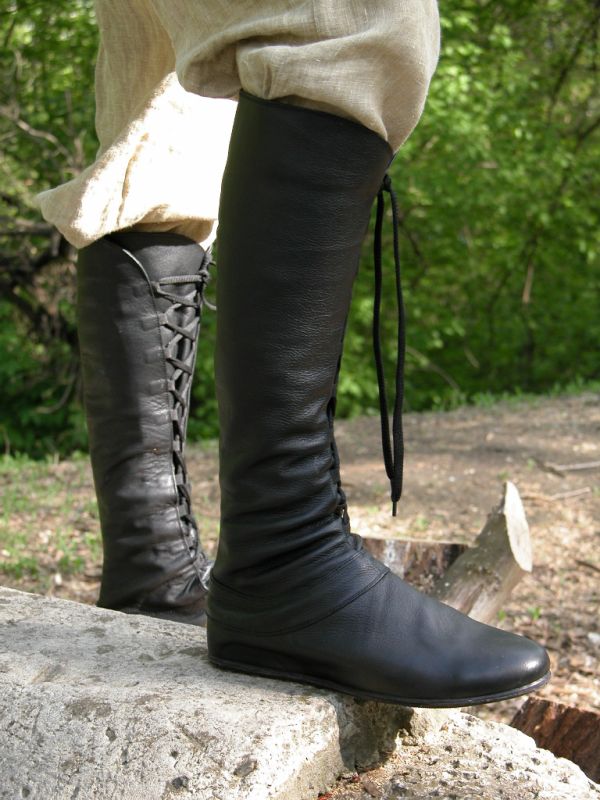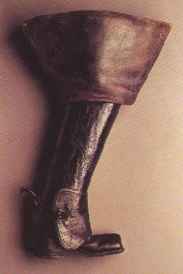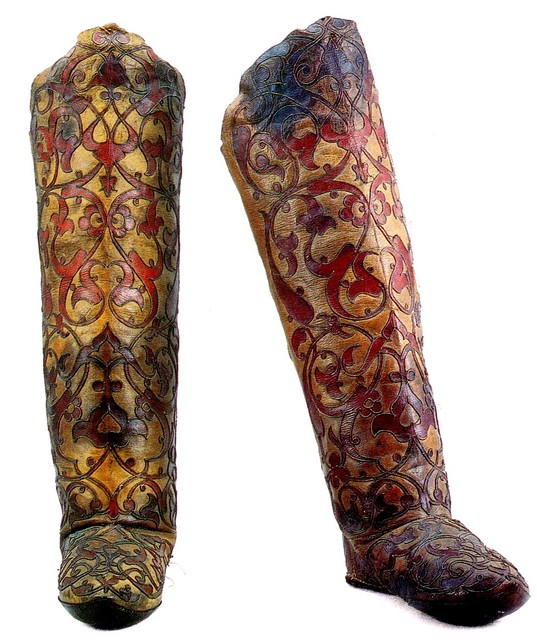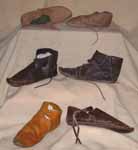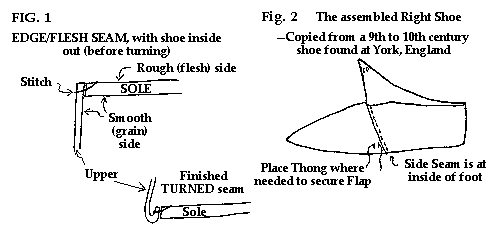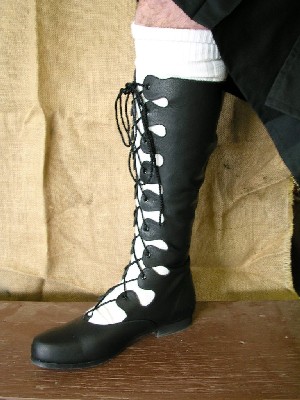Footwear
| This article may require cleanup. The specific problem is: information stolen from external site, needs reorganizing. Relevant discussion may be found on the talk page. Please help improve this article if you can. (April 2016) |
Contents
The shoe in history
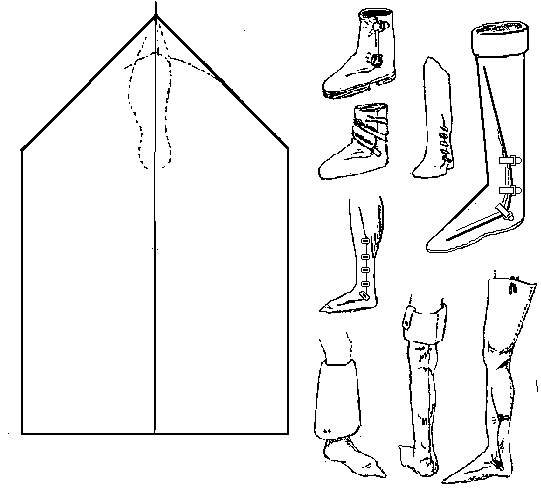
N. A shoe is an item of footwear. Shoes may vary from a simple flip-flop to a complex boot. Shoes may have high or low heels, although in western cultures, high heels are considered a women's style. Shoe materials include leather or canvas. Athletic shoe soles may sometimes be made of rubber.
The earliest known shoes date from about 8000 to 7000 BCE and were found in Oregon, USA in 1938. However, the materials used for making shoes (typically tanned leather) do not normally last for thousands of years, so shoes were probably in use long before this. Physical anthropologist Erik Trinkaus believes he has found evidence that the use of shoes began in the period between about 40,000 and 26,000 years ago, based on the fact that the thickness of the bones of the toes (other than the big toe) decreased during this period, on the premise that going barefoot results in greater bone growth before this period.
The earliest designs were simple affairs, often mere "foot bags" of leather to protect the feet from rocks, debris, and cold. Since a shoe uses more leather than a sandal, their use was more common amongst people in cold climates. By the Middle Ages, turn-shoes had been developed with toggled flaps or drawstrings to tighten the leather around the foot for a better fit. As Europe gained in wealth and power, fancy shoes became status symbols. Toes became long and pointed, often to ridiculous proportions. Artisans created unique footwear for rich patrons, and new styles developed. Eventually the modern shoe, with a sewn-on sole, was devised. Since the 17th century, most leather shoes have used a sewn-on sole. This remains the standard for finer-quality dress shoes today.
A boot is a type of shoe that covers at least the foot and the ankle and sometimes extends up to the knee or even the hip. Most have a heel that is clearly distinguishable from the rest of the sole, even if the two are made of one piece. Traditionally made of leather or rubber, modern boots are made from a variety of materials.
Throughout history, costume then fashion footwear have reflected social, economic and political developments. Usually what started as a practical application in one part of the globe ended up a as a fashion statement in another. Trade was primarly the reason for this movement but also war was another. The oldest boots in the world come from a clay impression originating in ancient Syria (Broby-Johansen, 1986). Cave painting in Spain dated between 12,000 and 15,000 BC, show a man in boots of skin and a woman in boots of fur. Persian funery jars of around 3000BC made in the shapes of boots show the basic forms of ancient footwear. Boots were also found in the tomb of Khnumhotep (2140-1785 BC) in Egypt. Perhaps the greatest paradox of boots is although they were essentially practical items of clothing they have always been worn as fashion items for all, but the lowly peasant. Fine boots were important indicators of social status before the sixteenth century and continued to be so up until beyond World War I. Over the centuries their style gradually became less flamboyant but that did not reduce their importance. Sixteenth century boots, as worn by the gentlemen class, were extravagantly decorative. More practical forms of boots began to develop especially for horse riding. The rigours of horseback meant boots needed to be more rigid and protective. Improvements in transport meant by the early nineteenth century boots became normal daytime footwear for all smart and fashionable men.Top boots and dress boots were made of the finest leathers to be worn with the breeches tucked in. As the century continued these calf high boots were superseded by the much less flamboyant boots and spats which signified the tempered Victorian male's approach to dressing for vanity. Boots were never as flashy again until stage and film cowboys revived them in the 20s and 30s. The author attempts to expand on these historical changes.
Shoes in Amtgard
From the Amtgard Beginners Guide, by Gwynne
Garb shoes. Where on Earth do you get them? Is there really such a thing? Do you have to spend afortune and have them custom made? The answers to all of these questions are (1) Wherever you can find them. (2) Yes, there really are garb shoes. and (3) No, not necessarily.Where do you get them? Shop a lot in “cheap” areas such as South El Paso. Some of those strangelittle shops will occasionally have the perfect soft boot or funky, totally medieval sandal you have been lustingfor. I would also recommend keeping an eye on the large department stores at the various malls. I have foundseveral pair of good garb boots at department stores- on sale yet! Major Renaissance events often have merchants selling garb shoes. Amtgard Garber’s Guild has also published patterns for soft cloth or leather shoes. If your belt pouch is of sufficient depth and weight you can also have boots custom made but.... be prepared to shop all over town for a bootmaker who has anything but a western type boot pattern. You’ll have better luck in Juarez, Mexico or similar areas with lower prices. Dress shoes for male and female are not nearly as difficult to obtain as the daily wear shoe or boot. Believe it or not the modern version of cloth or leather bedroom slipper is often so close to a traditional garbshoe as to make no difference. Whichever route you choose to take in your pursuit of garb shoes, be prepared to spend time if not money and keep fingers crossed as you will also need some luck!
Boots of the Middle Ages
In the middle ages the term boot referred to a type of slipper and generally was fur lined e.g. night watch boot. This type of footwear was often worn by the clergy. From the late 12-14th century a popular lightweight short boot was the estivaux another, more tightly fitting boot was the stivali. In England these soft boots were worn high and wider on the leg. They forced the wearer to adapt a bow legged gait and had the added disadvantage of allowing rain to pour into them. In France the stivali was worn tight on the leg. The boot was available in different colours with black the most popular but red was also worn. The name survives in German, steifel and the Italian, stivale. By the 14th century armed boots were reinforced with steel rods and chain mail. The military style was copied and made up in leather boots and became popular in the 14th and 15th centuries. These were worn by both men and women. At one time it was considered very fashionable to wear only one boot. The boots circa 1340 were according to Ribeiro & Cumming (1989), laced across the top of the foot. Alternatively ankle length boots were elaborately punched with small cruciform holes. Fashions for ankle length long pointed boots lasted well into the 1400Õs and by 1460 hose were worn with seems done the back of the leg and the ankle length boots were sometimes protected by pattens. Walking sticks became the vogue. By 1492 the toes of menÕs shoes became rounded.
Historical Shoes
Footwear has been worn for tens of thousands of years. Shoes of the past include:
Turn-shoes: A method by which the shoe is constructed inside-out, wetted, and turned — the finished side of the leather flipped to the outside. Such footwear was common from the Middle-ages until modern shoes was developed in the Tudor era. Because of their construction, turn-shoes cannot simply be re-soled, unlike most modern shoe types.
Espadrilles: these sandals, which are still worn today, are found as early as the 14th century. was a boot with straps laced through eyelets, or sophisticated version of the Greek crepida.
Patten: a European wooden overshoe used to keep a person's feet dry outdoors. First worn in the middle ages, they continued in use even into the early 20th century. Peoples such as the Dutch, Flemings, and some French carved similar, fully enclosed wooden shoes.
Poulaine: a shoe with a long-pointed toe, popular in Europe in the 1400s.
Moccasins: the historical shoe of many North American Indian tribes.
Mesopotanian Boot They wore boots made from kid leather with laced closures. Between 3000-1400BC in Crete, both men and women wore calf high boots tied to their legs with thongs. The boot had a strip of leather against the anterior aspect of the leg and secured below the knee with a band of leather. The top of the foot was covered.
Calceus Romans wore boots to keep their feet warm whilst living in colder climates. The military boots were hobnailed and depending on rank determined how far up the leg the boot could go. Victorious soldiers when they returned to Rome would have their copper hobnails removed and replaced with gold and silver ones.
Estivaux This type of footwear was often worn by the clergy in the middle ages, a tight fitting short boot that was often fur lined. Tighter versons of this boot were called stivali or in the German steifel.
Glossary of terms
Last: Foot shaped wooden form on which shoes are stretched and sewn.
Turn- Shoe: Shoe manufactured by stitching leather inside out in the early stages of construction.
Pattens: Wooden hinged sandals worn over shoes. Their purpose is to protect your shoes (and not incidentally your feet) from mud and abrasive surfaces.
Tunnel stitch: A stitch that does not completely penetrate the leather. Generally used for sewing on reinforcing cords and heel stiffener.
Reinforcing cord: A piece of linen cord that is tunnel stitched to leather to add strength. Often used across seams to strengthen them and prevent gapping. Also used around large, high stress openings to prevent the leather from stretching.
Heel stiffener: A piece of leather tunnel stitched over the heel to prevent undue stretching of the leather at this spot.
Sole The bottom of a shoe is called the sole.
Insole The insole is the interior bottom of a shoe, which sits directly beneath the foot. Many shoes have removable and replaceable insoles, and extra insoles are often added for comfort or health reasons (to control the shape, moisture, or smell of the shoe).
Outsole The outsole is the layer in direct contact with the ground. Dress shoes have leather outsoles; casual or work-oriented shoes have outsoles made of natural rubber or a synthetic imitation. The outsole may comprise a single piece, or may comprise separate pieces of different materials. Often the heel of the sole is rubber for durability and traction, while the front is leather for style. Specialized shoes will often have modifications on this design: athletic cleats have spikes embedded in the outsole to grip the ground; many kinds of dancing shoes have much softer or harder soles.
Midsole The layer in between the outsole and the insole that is typically there for shock absorption. Some types of shoes, like running shoes, have another material for shock absorption, usually beneath the heel where one puts the most pressure down. Different companies use different materials for the midsoles of their shoes. Some shoes may not have a midsole at all.
Heel The bottom rear part of a shoe is the heel. Its function is to support the heel of the foot. They are often made of the same material as the sole of the shoe. This part can be high for fashion or to make the person look taller, or flat for a more practical use.
Vamp, or upper Any shoe has an upper part that helps hold the shoe onto the foot. In the simplest cases, such as sandals or flip flops, this may be nothing more than a few straps for holding the sole in place. Closed footwear, such as boots, sneakers and most men's shoes, will have a more complex upper. This part is often decorated or is made in a certain style to look attractive. The U.S. Patent 3,355,535 , from 1967, describes a method for producing a shoe-upper (Hain 1967).
Turn Shoes how to
Left, shoes made by Matthew Amt. At top are two made from the pattern below, using garment leather and sewn by machine. Middle left is a 10th century style copying an example from Durham, and next to it is a very similar 12th century type. Both have chrome-tanned leather uppers, but are hand-stitched with proper turn-shoe construction. Bottom left is a 13th century shoe fastened by two overlapping tabs with little "toggles" (short knotted thongs in this case). Bottom right is an approximation of a 14th or 15th century shoe fastened with a forked strap that passes through a pair of holes and ties. The leather and construction are not quite right, but the overall effect is decent, and it has very correct repair soles sewn on with tunnel stitches. (All of these are for the right foot.)
Most medieval shoes were "turn shoes", sewn together inside out and then turned rightside out, to keep the stitching protected from wear. The sole is sewn to the upper with an edge/flesh seam: the stitch passes straight through the upper, then into the edge of the sole and out through the flesh (rough) side (fig 1). The edges of the uppers can be butted together and sewn with an edge/flesh seam, or simply overlapped and stitched straight through.
Like almost all shoes of the period, this pattern has an upper of one main piece with the seam on the inside of the foot; small inserts are added to close any gaps. The toe is pointed, and there can be an embroidered stripe running from the toe to the throat. Shoes were made with a right and left, and could be slip-ons or fastened with a drawstring.
Most surviving medieval shoes are made from very thin leather. Most reproductions are "over-engineered" and made from thicker leather (including my own), up to about 4 to 6-ounce for the uppers and 7 to 8-ounce for the soles. Be sure to use topgrain vegetable-tanned leather, not suede or chrome-tanned. (Click here for a page of leather tips: www.larp.com/legioxx/leather.html) Before doing any cutting, make a good working pattern out of scrap cloth and cardboard that fits your foot. The "seam allowance" around the bottom edge of the upper will be 1/4" to 3/8", but the sole should have NO seam allowance, since the upper is sewn against its edge. It will look very narrow.
When sewing the upper and sole together, start at the toe and sew the outside, then start again at the toe and sew the inside. Keep your stitches small and tight. A helpful trick is to glue the pieces together with leather glue or contact cement first, then stitch them. (Glue alone will NOT hold the pieces together without stitching!) Also, you may wish to turn the shoe before sewing the side seam or adding any inserts. The shoe must be soaked in water for several hours before it can be turned. When the shoe has been turned and has dried completely, coat it well with neatsfoot oil to make it waterproof and supple.
The thin soles of medieval shoes are not as protective as modern soles, of course, so you may want to insert padded or heavier leather insoles for more comfort. On the other hand, smooth leather soles can be slippery on wet grass, but a thin sole allows the toes to dig in more for better traction.
Shoes in Amtgard
Period footwear is probably the rarest kind of garb in all of Amtgard. As with many things there are 3 things to consider 1.) Good 2.) Fast 3.) cheap. Of those 3, odds are you're gonna have to settle for 2 of them.
You can make them yourself, sucker somone into making them for you, or buy some. Making shoes is not the eaisest thing in the world. Making shoes normally takes leatherworking skills and sewing skills, below I will attempt to layout what goes into making shoes, then links.
Leather is the material of choice for footwear. Latigo is the best kind, but it is expensive. Vegetable tanned leather is the second choice, it is the closest thing to period leather in stores. Chrome tanned leather should be avoided because after prolonged exposure to moisture the chrome salts will leach out and your leather will turn back to rawhide. Also it is worth to note many medieval Japanese shoes were made from woven grass.
The sole of a shoe is normally made from layers of leather at least 8oz thick stiched or glued together. not just any glue will due to keep the layers together, it's gotta be hella tough. Throughout history woden soled shoes have been worn and refered to as clogs (not those dutch shoes, though they are clogs most other clogs just had wooden soles) and were often worn by the poor. It was not uncommon for many shoes to be hobnailed to slow wear on the sole from ancient times through world war 2.
The uppers are normally leather as well, open toed uppers such as calige or ghillies (not open toed but does not need a last) often will negate the need for a last. The upper is usually sandwiched in the layers of the sole to keep it in place.
See also
- Tabi: Japanese split toe socks
- Geta; Japanese sandals
- Patten; Wooden outer shoes, worn by the Dutch
- Caligae; Roman sandal boot
- Moccasin; Native American footwear
- Button Boots; LARP boots popularized by Bald Mountain Moccasins
- Turn Shoes; European style shoe from 15th to 17th century, made inside out for part of construction
- Poulaine; European shoes with long pointed toes
- Ghillies; Scottish shoes and boots
- Bucket top boots; popular during the musketeer era
- Chopine; a women's platform shoe from Renaissance Italy
Links
- How to make shoe covers (images aren't preserved in this snapshot, but some information can be gleaned from the text)
- Honorable Shoe maker's Society
- "Footwear of the middle ages"
- Atlantian A&S on the topic
- Calcei
- A LOTR costume page's shoe department
- 1st century caligae (stereotypical roman boot)
- Historical footwear by Marc Carlson
- Gallery of Turn Shoes
- Roy Najecki
- Renboots
